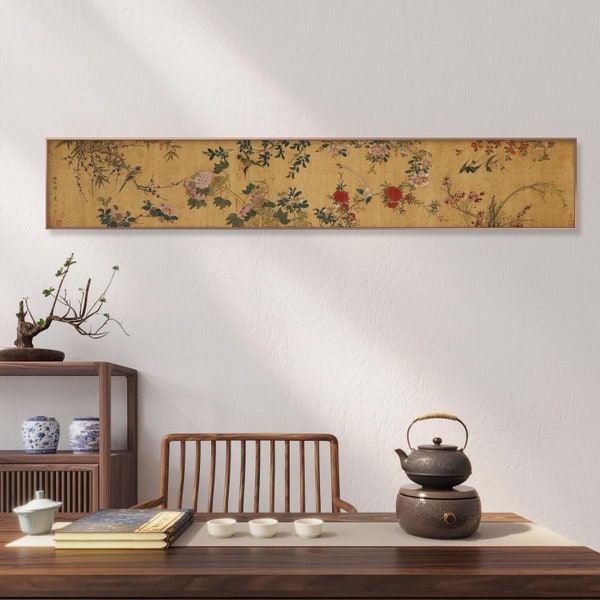In the realm of visual arts, few motifs resonate as profoundly as those reflective of the cyclical nature of seasons. The Chinese Four Seasons Wall Art encapsulates such a concept, merging aesthetic allure with rich cultural symbolism. This article delves into the intricate tapestry of harmony and design embedded in this art form, examined through the lens of cultural relativism. It is essential to unravel not only how this segmentation of time is represented but also what deeper psychological and sociocultural mechanisms underpin our collective fascination with the changing seasons.
The representation of the four seasons has a storied legacy in Chinese culture. Traditionally, each season is imbued with distinct characteristics and emotional resonances. Spring, with its burgeoning flora, symbolizes rebirth and renewal; summer, by contrast, embodies vibrancy and exuberance. Autumn is often viewed as a time of reflection and transition, while winter signifies dormancy and introspection. This cyclical understanding of time is not merely aesthetic; it echoes profound sentiments about natural rhythms and the human experience within them.
Investigating the aesthetics of the Chinese Four Seasons Wall Art reveals a multifaceted design approach that employs a variety of artistic techniques. The choice of colors, for example, can signify not only the seasons themselves but also the emotional states associated with each period. Pastel greens and vibrant blossoms typically characterize spring, invoking feelings of hope and optimism. In contrast, the muted browns and ochres of autumn invite contemplation, serving as a visual metaphor for the impermanence of life.
Moreover, these seasonal representations often utilize intricate motifs derived from Chinese symbolism. For instance, plum blossoms herald the arrival of spring, embodying resilience in face of adversity. Lotus flowers, closely associated with summer, symbolize purity and enlightenment, as they bloom from murky waters. Chrysanthemums, prevalent in autumnal artwork, reflect nobility and are often associated with longevity. Winter scenes may depict pine trees, emblematic of steadfastness amid adversity. The choice of flora anchors the art historically and culturally, facilitating a deeper connection to Chinese philosophical themes such as Daoism and Confucianism.
At a more profound psychological level, the allure of seasonal artworks often reflects a universal human yearning for harmony. Each segment of the year is distinctly unique yet interconnected, encapsulating the idea that existence requires balance, an idea pivotal in Eastern thought. This is where cultural relativism enriches our understanding. The appreciation for the four seasons is not unique to China; rather, it manifests across various cultures, albeit frequently in distinct guises. Hence, while the interpretations and symbolisms may diverge, there exists an underlying acknowledgement of life’s impermanence and the cyclical nature of existence.
Furthermore, the engagement with nature through this art form promotes a sense of mindfulness—a state increasingly sought after in today’s fast-paced world. Each season invites viewers to pause, reflect, and appreciate the transient beauty of life. The intricate designs act as a conduit for artistic expression, inviting individuals to contemplate not only their surroundings but also their own place within the ever-turning wheel of nature.
This reflection leads us to consider the significance of context and interpretation in the appreciation of such artworks. Cultural relativism asserts that an individual’s beliefs and values must be understood within their own cultural context. Thus, while Western perceptions of art may emphasize individual expression or aesthetic pleasure, Eastern perspectives often interlace spiritual meaning and communal significance — a collective experience that transcends the individual. The Chinese Four Seasons Wall Art serves as a manifestation of this difference, often viewed not merely as decoration but as a medium to transmit cultural heritage and shared values.
Critically, the dialogue surrounding this art form opens avenues for greater appreciation of the diverse ways cultures interpret their relationship with nature. The fascination that springs forth from the depiction of seasonal transitions encapsulates broader existential inquiries: How do we relate to time? What does it mean to experience change? Such inquiries challenge us to consider our individual and collective narratives and how these inform our understandings of beauty, resilience, and continuity.
Moreover, the global proliferation of Chinese Four Seasons Wall Art in contemporary spaces underlines an intriguing phenomenon: cross-cultural exchange. This exchange often blurs the lines of origin, allowing for an enrichment of meaning as these artworks are interpreted by audiences unfamiliar with their cultural roots. Each viewer brings forth their own contextual understanding, thereby enriching the artwork’s significance and illustrating the dynamic nature of cultural appreciation in a globalized context.
To conclude, the Chinese Four Seasons Wall Art stands as a compelling example of how artistry transcends mere aesthetics to evoke philosophical reflections about existence and harmony. Through the depths of symbolism and the intricate interplay of colors and forms, these artworks invite contemplation not just about nature and time, but about the universal human condition. As we navigate the changing seasons, both in nature and in life, the art serves as a poignant reminder of our interconnectedness with the world around us, encouraging a deeper understanding of the shared human experience. The broader narrative of this seasonal representation, viewed through a lens of cultural relativism, not only underscores the beauty of diversity but also highlights the common threads that unite us all in our journey through time.
